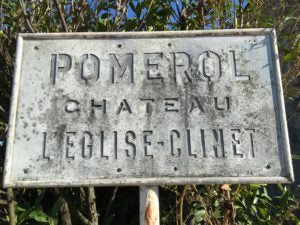Would You Know Your Bordeaux Wine From Your Claret? (Part 2)

Bordeaux Wine – Part 2
A Tale of Two Bordeaux– Left and Right Bank.
As outlined in my previous post, Bordeaux Wine Part 1, Bordeaux is home to a large number of wine-growing areas but is naturally divided by the Gironde Estuary, breaking it up into two main regions – the Left and Right Banks.
Neither one has anything to do with financial institutions, but a lot to do with wine making style, soil, culture, price, and prestige.
To recap, the left and right bank refers to either side of the Gironde Estuary and its two rivers, the Dordogne and Garonne. Land above the rivers is known as the Right Bank while anything below falls into the Left Bank. Between the two areas you’ll find the Entre Deux-Mers (between two seas), a sort of middle ground that produces good value wines.
Bordeaux wine – the Right Bank and Entres-Deux-Mers.
The number of differences between the Left and Right Bank would confuse any visitor (or wine student) to this area. For example, Left Bank chateaux often produce large quantities of bottles. Right Bank growers, on the other hand, release a very limited amount of wine, for very specific reasons.
Contrasts between the Right and Left Banks are as much cultural as geographical. The estate owners of the left bank are typically corporations or wealthy foreign investors whereas the typical right bank producer is a family-run business.
So, let’s head off to the north and east of Bordeaux City to discover the Right Bank (where the merlot grape is king) and to Entre-deux-Mers (a mainly white wine area).
Another big variant between the two Banks is the climate. Because the Right Bank is further away from the coast (Atlantic) it is more continental. The soil, richer in clay, is less gravelly. For this reason, merlot is the king of the Right Bank and dominates the red blends.
The merlot grape brings ripe, plummy red and black fruit aromas, and it is more supple and less austere than cabernet sauvignon. As a result, Right Bank blends are more approachable and can probably be more amenable even at an earlier stage of maturation. However, this does not mean these wines have less longevity.

Right Bank Appellations.
The Right Bank includes the famous appellations of St Émilion and Pomerol, as well as the more rustic regions of Bourg and Blaye.
St Émilion is the largest appellation in the Right Bank. The reds from this appellation have medium to high tannins, with a softer and richer mouthfeel than those from Medoc and are full of ripe red fruit and plum aromas. This area can be hard to get a handle on as it has 3 distinct types of terroir.
There’s the top of the plateau (limestone and thin, clay-loam topsoils); the slopes (deeper clay limestone and a dense blend of clay, sand and limestone); at the bottom of the slopes (sandy soils).
There are different quality levels which I’ll outline here:
• Saint-Emilion AC: the bottom of the appellation system
• Saint-Emilion Grand Cru Classe: next level up in quality
• Saint-Emilion Premier Grand Cru Classe: the highest level of the classification.
This rank is further divided into Saint-Emilion Premier Grand Cru Classe B, and Saint-Emilion Premier Grand Cru Classe A. The latter, being the best of the best.

Just a little northwest of St Émilion is the other major player in the Right Bank – Pomerol.
Wines from this district are generally richer and spicer than Saint-Emilion. Gearing more towards black fruit (ripe blackberry, black plums), they have luscious and heady fruitiness. The 900 producers here turn out some of the most expensive Bordeaux wine.
Interestingly Pomerol is the only AOC without a strict hierarchy of classifications. Merlot thrives on the plateaus as evidenced by the area’s most championed producer, Petrus. Their 100% Merlot is the gold standard for the varietal. In Pomerol, as it only covers 800 hectares (1,960 acres), scarcity helps its reputation.
For many estates however, the final blend depends all too much on sandy soil. As a result, the wines of Pomerol differ depending on where the vineyard is.
Apart from the two stars of Saint-Emilion and Pomerol, the Right Bank features other lesser known appellations. Fronsac and Canon-Fronsac are often overlooked.
The most elegant of the two is Fronsac but both have hidden gems at a good price point.
The Right Bank includes the famous appellations of St Émilion and Pomerol, as well as the more rustic regions of Bourg and Blaye #greenacresirl #bordeauxwine #discoverwine
Click To Tweet
Entres-Deux-Mers – This ‘middle kingdom’ is a large appellation reserved only for white wines. The reds from this area have to be labelled as Bordeaux AC or Bordeaux Supérieur AC. Although nowadays Entres-Deux-Mers is not the first appellation to come to mind when thinking of Bordeaux, it does have a long winemaking history.
It is in fact the oldest wine region in France. More than two millennia ago, the Romans brought viticulture here. Benedictine Monks kept the winemaking tradition alive during the Middle Ages and with their hard work, uplifted the reputation of the wines produced in this area.

Different Styles
Both Right & Left Bank red Bordeaux and made with traditional local grape varieties using similar wine making techniques, yet each bank has its own distinctive style.
Although it’s very difficult to generalise since each appellation and each estate has unique conditions and wine making philosophies, here’s a summary of the flavour profiles commonly found in the Right Bank:
• Usually dominated by Merlot so less tannic
• Softer, juicier style
• Rich aromas and flavours of dark berries, chocolate and liquorice which can develop into tobacco, fresh herbs and spices with ageing
• Easier to drink young
• Extended ageing can produce beautiful mature wines.
I hope that this brief introduction to the Right Bank of Bordeaux is comprehensive enough for you. Perhaps at some stage in the future I might expand on the various Chateaux and Owners but I think there is more than enough above to give you a flavour of the Right Bank.
My next post will be the last in the Bordeaux Wine trilogy and will outline the Left Bank of Bordeaux.
One last thing – did you know that we launched the Green Acres mobile app recently? Now you can bring us home in your pocket. Book tables, browse wines, learn of special offers, check events, connect with us, earn loyalty rewards and much more. We would really appreciate if you would click on either of the tabs below to download for free.
Talk to you soon – Cheers, James.

The post Would You Know Your Bordeaux Wine From Your Claret? (Part 2) appeared first on Green Acres.



